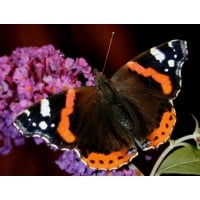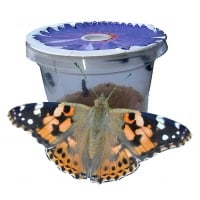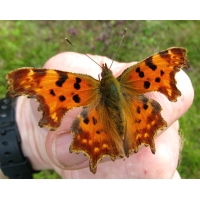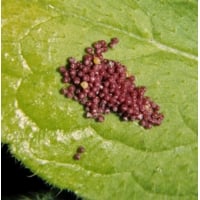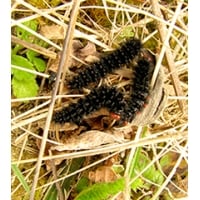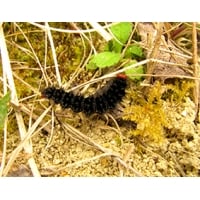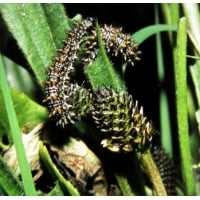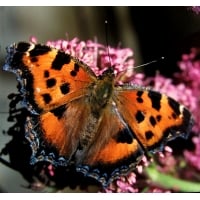SPRING and SUMMER EGGS and LARVAE Order now for supply in season
Red Admiral Vanessa atalanta
This is not a species for a beginner. Eggs are so small that a lens is needed to see them. When sent as larvae, as these are, they are usually tiny, needing a strong lens to see them before they start making leaf-tents. This is no problem for an experienced breeder, but is not as easy to look after as larvae that arrive at a visible size or as a cluster.
The larvae are solitary and make a nettle leaf into a tent. Inside the leaf tent the larva develops quickly in warm weather, sometimes moving to a bigger tent
The final shelter is where the larva hangs up and pupates. The butterflies will emerge this summer. If you can keep them on growing foodplant, either potted or sleeved outside, this is the best way to accommodate their need for fresh food as a shelter.
Larvae are too small to be put into a cage or aquarium. They are best reared on growing foodplant, enclosed in a sleeve.
Five Painted Lady larvae in Total Environment Pot
Available only for delivery to GB addresses, not international orders.
The five Painted Lady caterpillars live their whole life inside the see-through pot which contains all they need from birth to pupating. You need add no food. You don’t even clean them out and they look after themselves over weekends!
The larvae grow quite quickly in summer indoor conditions (never keep them in direct sunshine). The container is easily passed round a group without disturbance to the larvae.
During skin change the larvae do not move or eat This may last a day or two.
Don't be alarmed by this: it is a natural stage in their development.
When the larvae have finished eating, they suspend themselves from a silk pad spun on special absorbent paper in the lid. Here they cast their caterpillar skin. If you are lucky and look at the right moment you can see the actual moment of change from caterpillar to chrysalis.
Let the chrysalis harden for a couple of days, then hang the paper pinned inside a cage for the butterflies to emerge.
You can keep the butterflies for a few days in a cage with nectar flowers. Then, except in the colder months October to March, release them into the wild where they may breed naturally in your area. Please keep the larvae and pupae in an even room temperature (around 18-22º) day and night. Keep away from direct sunlight or a direct heat source such as a radiator.
The instructions are printed above - please note them for the arrival of the larvae which are not sent with further instructions. If you are sending larvae as a present, please remember the recipient will not have these instructions, unless you copy them to the recipient.
Can be ordered in advance. During the season there may be a delay of a couple of weeks or more if larvae are not currently at the size for sending.
Comma Butterfly Polygonia c-album
Fascinating larvae with curious half and half markings in black, brown and white, mimicking a bird dropping. The larvae feed on Stinging Nettle, Elm and Hop. Also Sallow, Osier Willow Salix viminalis, and sometimes other Willows. They live singly. Fast growing.
Young larvae will succeed best if placed on growing foodplant. Enclose plant and pot in a netting sleeve, tied at both ends: size 3 is ideal. Otherwise you can sleeve Comma larvae on branches of Elm, Sallow and Willows, including Osier. Good ventilation is required. Cut food is not recommended at least until the larvae are nearly half grown. Comma larvae do not like crowding, and do best kept so that each caterpillar can get away and live on its own. Disease can occur if conditions are not perfect. If it does, it helps that the larvae live separately. Any infected or dead larvae should be removed and disinfection should be carried out, lightly spraying 10% bleach solution, which will not affect healthy larvae, but does help prevent the spread of disease.
This garden butterfly is capable of re-colonising places where it used to be. In autumn the butterflies are very partial to fallen fruit. With some help this butterfly could be encouraged to spread.
Keeping two species of larvae together on the same foodplant? It is sometimes possible, but their way of life may differ and we recommend keeping them separately. Comma larvae live solitary lives and should be reared in their own enclosure.
Dark Green Fritillary Mesoacidalia aglaia
Best reared on potted Violet. These larvae are in hibernation. Keep the larvae in winter out of doors, in all weathers, protected amongst dead bramble and other leaves, amongst growing Violet. Cover with netting sleeve to exclude predators and to prevent escape.
Marsh Fritillary Eurodryas aurinia
It's a very long time since we have been able to offer egg masses. Each mass should produce 100-200 larvae. Amazing value!
They feed low amongst the leaves of Devil’s Bit Scabioius, but will also eat Honeysuckle. Honeysuckle starts leafing very early in the year, especially where sheltered in woodland. By February it is not diffficult to find enough foodplant to keep caterpillars well fed. In captivity the larvae are recorded as accepting Ribwort Plantain Plantago lanceolata, Teasel Dipsacus and Snowberry Symphoricarpos.
Cage or sleeve the larvae on growing foodplant, kept out of doors in a spot sheltered from extreme wind, but open to all weather, including frost, rain and snow. This is what winter throws at them in the wild, and they are adapted to it.
After waking in the spring the larvae grow fast, pupating in April and emerging as butterflies in May.
Marsh Fritillary Eurodryas aurinia
Larvae feed low amongst the leaves of Devil’s Bit Scabioius, but will also eat Honeysuckle. Honeysuckle starts leafing very early in the year, especially where sheltered in woodland. By February it is not diffficult to find enough foodplant to keep caterpillars well fed. In captivity the larvae are recorded as accepting Ribwort Plantain Plantago lanceolata, Teasel Dipsacus and Snowberry Symphoricarpos.
Pre-hibernation larvae might be induced to develop and produce another generation with long day-length and sufficient warmth.
After waking in the spring the larvae grow fast, pupating in April and emerging as butterflies in May.
Glanville Fritillary Melitaea cinxia
Feed on Narrow-leaved Plantain. Easiest to keep on potted foodplant, enclosed in a sleeve. The larvae are gregarious, living in a tight bunch at the base of the plant, and spreading out more as they grow larger. The ginger head capsule and jet black body distinguish these larvae from other species.
In Britain this species lives mainly on the Isle of Wight coast, but they have been established elsewhere in Britain. Maybe they could be encouraged in more localities.
These larvae will produce butterflies this spring.
Glanville Fritillary Melitaea cinxia
EGG MASS, never offered before, is best attached to a large and healthy potted foodplant where the larvae can hatch, live in a web and eventually hibernate. We advise keeping the pot caged or sleeved, for protection from predators. An egg mass will produce dozens of larvae.
Feed on Narrow-leaved Plantain. Easiest to keep on potted foodplant, enclosed in a sleeve. The larvae are gregarious, living in a tight bunch at the base of the plant, and spreading out more as they grow larger. The ginger head capsule and jet black body distinguish these larvae from other species.
In Britain this species lives mainly on the Isle of Wight coast, but they have been established elsewhere in Britain. Maybe they could be encouraged in more localities.
Heath Fritillary Melicta athalia
Allow the hatching larvae to feed and establish themselves in a pot of foodplant. Sleeve pot and all and leave out of doors for hibernation, exposed but in a place that drains.
Common in parts of Europe, and a rare and very localised species in Britain. The larvae thrive on narrow-leaved Plantain Plantago and bear a remarkable resemblance to its flowerheads. Larvae supplied in July/August will normally hibernate, but in warm conditions, some may grow and produce butterflies again this year.
Hibernation is best carried out with larvae on a substantial potted foodplant, pot and plant sleeved for protection. Keep outside in all weathers but away from flooding.
Pearl-bordered Fritillary Clossiana euphrosyne
Becoming rather a scarce species. Very difficult to obtain.
Larvae best kept on a pot of violet enclosed in a sleeve or escape-proof cage.
Yellow-legged Tortoiseshell Nymphalis xanthomelas
A very handsome and richly coloured Large Tortoiseshell which occurs in parts of Europe and in the Far East. Foodplants: Willows, Sallows, Elm, and probably many other trees, including those for polychloros. The butterfly, caterpillar and pupae are all brighter and grander than polycholoros. HIGHLY RECOMMENDED!
Large Tortoiseshell Nymphalis polychloros
Exceptionally difficult to obtain.
One of Europe’s grand butterflies! Now thought to be extinct in Britain. The larvae feed on a variety of fruit trees, Willow, Sallow, Elms, Aspen, Poplars and Birches. Easy to rear, particularly when sleeved on growing foodplant, but protect from excessive rain. Butterflies are produced this year. A very popular species. Please order early. Could you help establish this extinct British species in your area?

